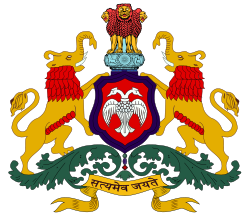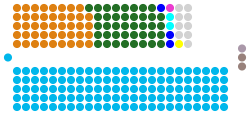Legislative Assembly of Karnataka
| Karnataka Legislative Assembly | |
|---|---|
| 14th Assembly | |
 |
|
| Type | |
| Type | |
|
Term limits
|
5 years |
| Leadership | |
|
Speaker
|
|
|
Deputy Speaker
|
|
|
Leader of the House
|
|
|
Leader of the Opposition
|
|
| Structure | |
| Seats | 225 |
 |
|
|
Political groups
|
Government (124)
INC (123)
Speaker (1)
Opposition (99)
BJP (44)
JD(S) (39)
BSRC (3)
KJP (2)
KMP (1)
SKP (1)
Independents (9)
Others (2)
Nominated (1)
Vacant (1)
|
| Elections | |
| First-past-the-post | |
|
Last election
|
5 May 2013 |
|
Next election
|
2018 |
| Meeting place | |
 |
|
| Legislative Assembly Chamber, Vidhana Soudha, Bangalore, Karnataka | |
| Website | |
| Karnataka Legislative Assembly | |
| Footnotes | |
| The Council was established in 1881 for the Princely State of Mysore. The Princely state was merged with the Union of India and became Mysore State in 1950; Mysore State was re-organized to its current territorial state in 1956 and renamed as Karnataka on 1 November 1973. | |
Government (124)
Opposition (99)
Others (2)
The Karnataka Legislative Assembly is the lower house of the bicameral legislature of Karnataka state in southern India. Karnataka is one of the seven states in India, where the state legislature is bicameral, comprising two houses. The two houses are the Vidhan Sabha (lower house) and the Vidhan Parishad (upper house).
The members of the Vidhana Sabha are directly elected by people through adult franchise.
There are 224 members of the Vidhana Sabha or the Legislative Assembly of Karnataka state. One member is a representative of the Anglo-Indian community nominated by the Governor of Karnataka. The state of Karnataka is divided into 225 constituencies used to elect the Legislative assembly.
Each constituency elects one member of the assembly. Members are popularly known as MLAs. The assembly is elected using the simple plurality or "first past the post" electoral system. The elections are conducted by the Election Commission of India.
The normal term of the members lasts for five years. In case of death, resignation or disqualification of a member, a by-election is conducted for constituency represented by the member. The party which wins the most seats becomes the ruling party.
In the 2013 elections, the Indian National Congress (INC) won a majority of seats, with 122 out of 224 MLAs. On 10 May 2013, Siddaramaiah was chosen as Chief Minister and CLP leader by the MLAs. He was sworn in as CM on 13 May 2013.
...
Wikipedia
